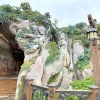 Scattered across the landscape of Japan are Shinto shrines of various shapes and sizes. In many of the larger shrines you’ll find one or more especially old trees known as Goshinboku which means “sacred tree.”
Scattered across the landscape of Japan are Shinto shrines of various shapes and sizes. In many of the larger shrines you’ll find one or more especially old trees known as Goshinboku which means “sacred tree.”
Sacred trees are usually massive in size and centuries old with some reportedly over 1,000 years old. You can usually tell them from the shimenawa wrapped around their trunks. A shimenawa is an extremely thick rope which encloses something holy and wards off evil from outside.
These age-old trees are beautiful specimens of nature’s strength and longevity and add an extra level of serenity to their shrines. However, in the past month someone or some group has been killing off these sacred trees of shrines in 5 separate prefectures in Japan’s mid-west.
The So-Kawachi Daimei Shrine in Ehime Prefecture sits in the tiny remote village of Namegawa nestled in the mountainous outskirts of Toon (T-OH-N) city. It is home to a pair of sacred hinoki (Japanese cypress) trees each over 500 years old.
In September 2012, strange holes were found around the base of their trunks and substantial withering was taking place throughout the trees. A subsequent police investigation found traces of chemical used an “arboricide” or tree poison.
After long consideration the shrine determined that the considerably weakened trees posed a risk of collapse and needed to be cut down on 26 December.
The day before, the head priest and townspeople held a ritual to pray for the safe removal of the trees. The priest gave a Shinto prayer known as a norito to thank the trees for their protection of the shrine from the elements for so many years.
“For many years these trees and I have watched over this shrine. With the trees gone, there is only emptiness” said the head priest in a eulogy fused with frustration over someone deliberately killing these landmarks of his shrine.
He then faced the trees one last time and gave an offering of rice and salt so that their souls may be calmed. The following day, after half a millennium, the two trees came down.
As a result of this incident the Japanese Forestry Agency conducted an emergency survey for sacred trees that died by human hands. What they found was a string of sacred tree poisonings across several prefectures west of Aichi.
Kochi Prefecture was hit the hardest with seven sacred trees killed off at shrines located in sparsely populated areas. Tokushima saw three trees die and Wakayama and Aichi prefectures each had one death. Including the twin trees in Ehime Prefecture, the toll comes to 14.
In each case, holes were drilled into the trunks at a depth of about 4cm and a tree killing chemical was injected. The chemical could then travel up the trees’ xylem which act like veins and delivers the poison throughout the plant.
Authorities speculate that the trees were poisoned and killed in an effort to get their “sacred” lumber that would fetch an extremely high price as a building material.
The Forestry Agency sent out warnings to all local law enforcement in an effort to better coordinate and track the tree killer or killers.
Considering the punishment for stealing ten yen from a temple, there’s likely a hefty punishment for destroying ancient holy trees at shrines in Japan. Even if whoever killed the trees isn’t caught, they’re definitely racking up bachiatari (bad karma) by the truck load.
Source: NHK, 47 News via My Game News Flash (Japanese)
Image: Chris Gladis – Wikipedia
▼ Site of the twin sacred tree victims in Ehime Prefecture.

 Hang in there, Baby!: Cat clinging to wall in Tokyo caught on Google Maps
Hang in there, Baby!: Cat clinging to wall in Tokyo caught on Google Maps Tokyo woman mugged for 3,000 yen, haggles mugger down to 1,000
Tokyo woman mugged for 3,000 yen, haggles mugger down to 1,000 Seamen in Hokkaido shocked to discover bright lavender crab
Seamen in Hokkaido shocked to discover bright lavender crab Watch the “world’s largest firework” go off 【Video】
Watch the “world’s largest firework” go off 【Video】 We visit “the best conveyor belt sushi restaurant in Japan”
We visit “the best conveyor belt sushi restaurant in Japan” Starbucks Japan ready to get Year of the Horse started with adorable drinkware and plushies【Pics】
Starbucks Japan ready to get Year of the Horse started with adorable drinkware and plushies【Pics】 We found possibly the quietest Japanese-style hotel in Tokyo’s bustling Shinjuku district
We found possibly the quietest Japanese-style hotel in Tokyo’s bustling Shinjuku district Official Fist of the North Star whisky goes on sale in Japan
Official Fist of the North Star whisky goes on sale in Japan What do you eat when you catch a cold? We asked 11 of our Japanese reporters
What do you eat when you catch a cold? We asked 11 of our Japanese reporters Japanese thug wear from Birth Japan perfect for those breaking bad next year
Japanese thug wear from Birth Japan perfect for those breaking bad next year Muscly Japanese men fill stock photo site with hilarious poses in unusual settings
Muscly Japanese men fill stock photo site with hilarious poses in unusual settings Major Japanese noodle chain is closing on Christmas Eve so workers can spend time with families
Major Japanese noodle chain is closing on Christmas Eve so workers can spend time with families Japan’s human washing machines will go on sale to general public, demos to be held in Tokyo
Japan’s human washing machines will go on sale to general public, demos to be held in Tokyo Tokyo DisneySea’s Frozen Kingdom: Elsa’s home at Fantasy Springs has a surprising attraction
Tokyo DisneySea’s Frozen Kingdom: Elsa’s home at Fantasy Springs has a surprising attraction We eat imoni, a delicious autumn stew, at a unique version of a traditional Japanese festival
We eat imoni, a delicious autumn stew, at a unique version of a traditional Japanese festival Lacquerware supplier to emperor of Japan and Pokémon team up for new tableware
Lacquerware supplier to emperor of Japan and Pokémon team up for new tableware Japan may add Japanese language proficiency, lifestyle classes to permanent foreign resident requirements
Japan may add Japanese language proficiency, lifestyle classes to permanent foreign resident requirements 7-Eleven Japan’s ramen-cooking robot whipped us up a bowl of noodles【Taste test】
7-Eleven Japan’s ramen-cooking robot whipped us up a bowl of noodles【Taste test】 Cyberpunk anime meets traditional culture in Ghost in the Shell gold leaf Japanese changing screens
Cyberpunk anime meets traditional culture in Ghost in the Shell gold leaf Japanese changing screens Disillusionment at Tsukiji’s tourist-target prices led us to a great ramen restaurant in Tokyo
Disillusionment at Tsukiji’s tourist-target prices led us to a great ramen restaurant in Tokyo 7 great places to see Mt. Fuji from without having to climb it
7 great places to see Mt. Fuji from without having to climb it Hello Kitty Choco Egg figures are an adorable trip through three periods of Japanese pop culture【Pics】
Hello Kitty Choco Egg figures are an adorable trip through three periods of Japanese pop culture【Pics】 Starbucks Japan releases new zodiac chilled cup drink for 2026
Starbucks Japan releases new zodiac chilled cup drink for 2026 Japan’s otoshidama tradition of giving kids money at New Year’s gets a social welfare upgrade
Japan’s otoshidama tradition of giving kids money at New Year’s gets a social welfare upgrade 7-Eleven Japan starts new temporary luggage storage service in over 300 branches
7-Eleven Japan starts new temporary luggage storage service in over 300 branches Starbucks teams up with 166-year-old Kyoto doll maker for Year of the Horse decorations【Photos】
Starbucks teams up with 166-year-old Kyoto doll maker for Year of the Horse decorations【Photos】 Tokyo considering law requiring more trash cans following litter increase in heavily touristed area
Tokyo considering law requiring more trash cans following litter increase in heavily touristed area Tokyo’s Tsukiji sushi neighborhood asks tour groups to stay away for the rest of the month
Tokyo’s Tsukiji sushi neighborhood asks tour groups to stay away for the rest of the month Nintendo’s Kirby now delivering orders at Kura Sushi restaurants, but not in Japan
Nintendo’s Kirby now delivering orders at Kura Sushi restaurants, but not in Japan Tokyo event lets you travel back in time, for free, to celebrate 100 years since Showa era start
Tokyo event lets you travel back in time, for free, to celebrate 100 years since Showa era start Sanrio theme park in Japan announces plans to expand into a Sanrio resort
Sanrio theme park in Japan announces plans to expand into a Sanrio resort Stamina-destroying “Paralysis Noodles” are Tokyo’s newest over-the-top ramen innovation
Stamina-destroying “Paralysis Noodles” are Tokyo’s newest over-the-top ramen innovation Survey asks foreign tourists what bothered them in Japan, more than half gave same answer
Survey asks foreign tourists what bothered them in Japan, more than half gave same answer Japan’s deadliest food claims more victims, but why do people keep eating it for New Year’s?
Japan’s deadliest food claims more victims, but why do people keep eating it for New Year’s? We deeply regret going into this tunnel on our walk in the mountains of Japan
We deeply regret going into this tunnel on our walk in the mountains of Japan Studio Ghibli releases Kodama forest spirits from Princess Mononoke to light up your home
Studio Ghibli releases Kodama forest spirits from Princess Mononoke to light up your home Major Japanese hotel chain says reservations via overseas booking sites may not be valid
Major Japanese hotel chain says reservations via overseas booking sites may not be valid Put sesame oil in your coffee? Japanese maker says it’s the best way to start your day【Taste test】
Put sesame oil in your coffee? Japanese maker says it’s the best way to start your day【Taste test】 No more using real katana for tourism activities, Japan’s National Police Agency says
No more using real katana for tourism activities, Japan’s National Police Agency says Starbucks Japan reveals new sakura drinkware collection, inspired by evening cherry blossoms
Starbucks Japan reveals new sakura drinkware collection, inspired by evening cherry blossoms Updated cherry blossom forecast shows extra-long sakura season for Japan this year
Updated cherry blossom forecast shows extra-long sakura season for Japan this year My Melody and friends featured at pop-up cafe in Tokyo
My Melody and friends featured at pop-up cafe in Tokyo Mt. Fuji’s World Heritage status provides fame for associated moe character Saori
Mt. Fuji’s World Heritage status provides fame for associated moe character Saori We try Sexual Harassment Sushi, Soapland Sushi, and Ice Cream Sushi
We try Sexual Harassment Sushi, Soapland Sushi, and Ice Cream Sushi Expert mode “Rainbow Road” bridge found in Japan
Expert mode “Rainbow Road” bridge found in Japan We Head to the Location of OS X Mountain Lion’s Desktop, “Blue Pond” and Soak In the Mysterious Beauty First Hand
We Head to the Location of OS X Mountain Lion’s Desktop, “Blue Pond” and Soak In the Mysterious Beauty First Hand Sacred 1,200-year-old tree toppled by severe storm at shrine in central Japan【Photos】
Sacred 1,200-year-old tree toppled by severe storm at shrine in central Japan【Photos】 Fujiyamashita Station: Crushing Dreams Since 1928
Fujiyamashita Station: Crushing Dreams Since 1928 Outbreak of Rare Phantom Squid in Pacific Coast of Japan May Herald Imminent Earthquake
Outbreak of Rare Phantom Squid in Pacific Coast of Japan May Herald Imminent Earthquake We Visit the Shrine of the Dolls, Where Creepiness Turns to Inspiration and a Doll Has Hair that Grows
We Visit the Shrine of the Dolls, Where Creepiness Turns to Inspiration and a Doll Has Hair that Grows Lettuce farmers of “Miracle Village” looking for love – benefits include cute dogs and a six-figure salary
Lettuce farmers of “Miracle Village” looking for love – benefits include cute dogs and a six-figure salary Get your car washed right: get it washed by some girls in swimsuits for 100 bucks
Get your car washed right: get it washed by some girls in swimsuits for 100 bucks We try one meter of skewered grilled chicken: The Mega-Yakitori
We try one meter of skewered grilled chicken: The Mega-Yakitori Petition to protest bulldozing of Ghibli-featured shrine gathers over 10,000 signatures worldwide
Petition to protest bulldozing of Ghibli-featured shrine gathers over 10,000 signatures worldwide Orange-flavored rice balls: Japan’s newest way to fuse vitamin C and carbs
Orange-flavored rice balls: Japan’s newest way to fuse vitamin C and carbs Charges dropped against elderly Japanese man for nailing Putin voodoo doll to sacred shrine tree
Charges dropped against elderly Japanese man for nailing Putin voodoo doll to sacred shrine tree Japanese police hide at shrine in camo gear to catch a thief…who stole six bucks 【Video】
Japanese police hide at shrine in camo gear to catch a thief…who stole six bucks 【Video】
Leave a Reply